

What's the alternative to Cortina uprights. I may have ruined mine and as they seem to be as rare as rocking horse pooh I thought there must be
an alternative. I'd like to keep my Cortina hubs, discs and calipers as they are all new.
Cheers
Jon
I started looking for a Hyundai Stellar and found an '88 one but I think the uprights were only the same on the '85-'86 models. Am I
right?
Cheers
Jon
A couple of chaps over here in Oz have used LiteAce Toyota van uprights with some success. They may be a bit heavier than the corty ones, but they
have more modern brakes (some are even vented!).
The uprights from a Holden/Isuzu Gemini are also quite good, but they might be difficult to find over there.
The only prob with using alternative is trying to get the geometry right....
quote:
The uprights from a Holden/Isuzu Gemini are also quite good, but they might be difficult to find over there.

If you don't mind me asking, what did you do to ruin the uprights ?
They may be recoverable.
Mick
just about to ask the same question and maybe off to take the ruined ones off your hands.
raceleda do uprights to replace cortina units
quote:
Originally posted by mangogrooveworkshop
raceleda do uprights to replace cortina units



My cycle wing brackets bolt on using the top TRE. This means that the thread doesn't protrude enough once the locknut is fitted. So I had a
bright idea. I turned the nuts down to make half nuts. Still it wasn't enough. So I ground down the upright with an angle grinder and took too
much off. I underestimated the efficiency of the equipment I was using! Instead of it measuring 22.5mm it now measures 16.5mm. That's a lot of
meat to remove and I'm worried it may have weakened the upright. It looks strong enough but you can't afford to mess around too much with a
steering component, so I thought I'd get some new ones to be on the safe side (more expense) and then order some brackets which have an
alternative fixing method.
Cheers
Jon
quote:
Originally posted by Mix
If you don't mind me asking, what did you do to ruin the uprights ?
They may be recoverable.
Mick
That doesn't sound too bad on the face of things, I'll have a look at my untouched ones when I get home and post my opinion.
Mick
85-86 Hyundai Stellar is exactly the same as Cortina. After that they are struts.
if you do want to get rid of them - sling them my way, i might have a novel use for them.
I'm sure a few beer tokens will get slung back.
Ok (prepared to be shot down)
If you have taken the 6mm off of the top of the TRE attachment hole I think you could get away with it.
I say this because:
It is possible to file the upright into a smooth curve here to reduce stress raisers.
The section of the upright as it curves into the area where the TRE is attached will still be of a lesser or equal section to the area where the TRE
attaches. (ie you haven't reduced the section below what was already the smallest area)
The amount of metal you have removed is proportionally less as the hole is larger at the top than the bottom.
The upright was designed to take the loads imposed by a much heavier vehicle and not to be scrutinised often, if at all.
I would be confident enough to fit them and take it easy for a while and keep an eye on the TRE attachments. What you have is probably stronger than a
lot of alloy equivilents.
At the end of the day you will have to decide what you are happy with.
Mick
Don't Westfield mill them down for the same reason, to put a bracket under them ?. I can't see there being any problem with the thickness of metal you have left as long as the taper locks and doesn't show through your bracket. You could weld a 5mm plate on top and drill through it to make it back up.
I ground the bottom of the TRE attachment hole!
quote:
Originally posted by Mix
Ok (prepared to be shot down)
If you have taken the 6mm off of the top of the TRE attachment hole I think you could get away with it.
I say this because:
It is possible to file the upright into a smooth curve here to reduce stress raisers.
The section of the upright as it curves into the area where the TRE is attached will still be of a lesser or equal section to the area where the TRE attaches. (ie you haven't reduced the section below what was already the smallest area)
The amount of metal you have removed is proportionally less as the hole is larger at the top than the bottom.
The upright was designed to take the loads imposed by a much heavier vehicle and not to be scrutinised often, if at all.
I would be confident enough to fit them and take it easy for a while and keep an eye on the TRE attachments. What you have is probably stronger than a lot of alloy equivilents.
At the end of the day you will have to decide what you are happy with.
Mick
Build it back up, you haven't altered the taper so it shouldn't make any difference where you took it from. As long as the nut locks the
taper into the hole they should be strong enough at 16mm thick. It should work with a thick washer making up the difference.
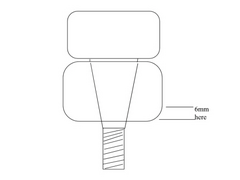

Rescued attachment tre.jpg
You don't need to hunt down rare/expensive uprights; just make your own! 
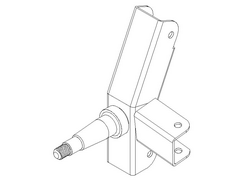

Rescued attachment upright_01.jpg
Birdseye view (steering turned).
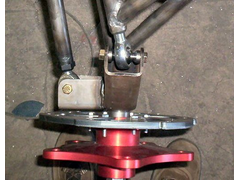

Rescued attachment upright_02.jpg
couple of questions,
1) where do you get the spindle from?
2) why not make it out of one veritcal peice of steel instead of an angles piece (is this to make it the same as the cortina bit) (edit - 5 hours
later, i remember, rod end)
3) where did you get the bits that the ...... arrghh, forgot the word, the bit that you've used instead of a transit drag link?
4) how do you know it will stand up to the strain of road use? ie not checked every 30 miles.
[Edited on 1/10/05 by MikeR]
ok, i can't count!
quote:
Originally posted by MikeR
couple of questions,
1) where do you get the spindle from?
2) why not make it out of one veritcal peice of steel instead of an angles piece (is this to make it the same as the cortina bit)
3) where did you get the bits that the ...... arrghh, forgot the word, the bit that you've used instead of a transit drag link?
4) how do you know it will stand up to the strain of road use? ie not checked every 30 miles.
As usual, answers provoke more questions,
1) For the hole builder, wouldn't it be better trying to source bolt on spindles or do you think its easy to weld them together (thinking the
average home builder has prob max 150 amps.)
2) ignore the question, i wasn't thinking when i asked it, forgot about trying to get the wheel to camber in corners.
3) I wasn't meaning the rod end itself, but the bit the rod end is going through between the two vertical bits of steel. I'd normally use a
bolt and lots of washers / spacer.
4) Any chance of supplying the spec ie thickness / grade of steel used?
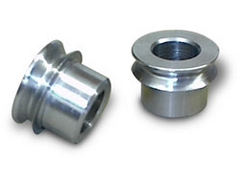

quote:
Originally posted by iank
Capri might be an alternative (used by Sylva on the Riot). Didn't early Sylva's use the Chevette uprights?
quote:
Originally posted by Rorty
I doubt if you would find any bolt-on stub axles
quote:
Originally posted by gazza285
quote:
Originally posted by Rorty
I doubt if you would find any bolt-on stub axles
Could you not use the VAG ones that youmentioned the other day?
I know, just thinking about cost and availability.
Raceleda do a Cortina sized stub axle, but they won't tell you the price on the website.
quote:
Originally posted by gazza285
... they won't tell you the price on the website.
Its been a while since I've used a lathe in anger though, have to dig out the micrometers.......
quote:
Originally posted by Rorty
quote:
Originally posted by gazza285
... they won't tell you the price on the website.
That usually means you'd be able to make them cheaper yourself.

We want the price of the stub axle, not the complete upright kit.
Out of sheer curiosity I just compared the mass of the various Cortina uprights.
The standard cast steel upright as found on the Cortina car weighs in at 2.58kg (bare).
The RHS upright illustrated above comes in at 1.74kg and the keyed plate upright below comes in at 1.86kg.
I forgot to add the light weight racing uprights which weigh .898kg.
[Edited on 4/10/05 by Rorty]
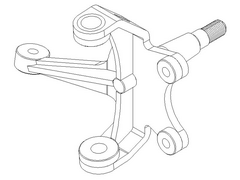

Rescued attachment Cort_upright_02.jpg
Rorty,
Why can't the stub shafts be used in standard form? I've no idea what the standard ones look like and I assume that there is a good reason
for you to turn the ends down, I'm just trying to understand this mod. Is there a before and after pic?
I assume that what you end up with is a flange followed by a 16mm spigot. The flange buts up against the side of the 50x50 tube. The spigot goes
through two light interference holes to the other side of the 50x50 tube and protrudes by a few mm. You then weld around this protrusion to secure the
stub shaft.
What do your "top shelf" uprights look like, Are there any descriptions or pics?
quote:
Originally posted by cymtriks
Rorty,
Why can't the stub shafts be used in standard form? I've no idea what the standard ones look like and I assume that there is a good reason for you to turn the ends down, I'm just trying to understand this mod. Is there a before and after pic?
I assume that what you end up with is a flange followed by a 16mm spigot. The flange buts up against the side of the 50x50 tube. The spigot goes through two light interference holes to the other side of the 50x50 tube and protrudes by a few mm. You then weld around this protrusion to secure the stub shaft.
What do your "top shelf" uprights look like, Are there any descriptions or pics?
quote:
Originally posted by gazza285
Its been a while since I've used a lathe in anger though, have to dig out the micrometers.......
quote:
Originally posted by Rorty
- I doubt if you would find any bolt-on stub axles and the cost of turning aa thread on a plain one would far exceed the cost of having someone weld one on (if the DIY welder wasn't up to the job).
Incidently, I turn down the back of the stub axle to form a 16mm dia. spigot which goes right through the entire box tube and I then rose-weld it to the other side of the RHS. This anchors the stub securely and really beefs up the whole upright.
- OK
- Ah, sorry. Those are ball extenders! They extend the ball bearing and effectively increase the bearing surface and thus the angle of operability. They also have a convenient spacer built-in. The extenders also step down the size of the bolt through them, normally by just one size, so you'd need to remember that when drilling the holes in the uprights.
I usually make them up for the job in hand from stainless steel. See pic below.
- No worries; the RHS is nothing more than common 50 x 50 x 3 mild steel box tube and the stub axles vary but IIRC, the grade you'd use in the UK is something like EN16. Many trailer stub axles aren't even as good as that yet they hold up OK.
Not wishing to take trade away from anybody on here, but my old famous quote kicks in once more!!!...............................ring GB Engineering
in Nantwich!
They make strong, lightweight uprights, complete with alloy hubs, bearings, brake disc (to suit bike calipers) and steering arms, for £250 a pair. As
tested by around 1000 autograssers most weekends in the UK.
quote:
Originally posted by NS Dev
Not wishing to take trade away from anybody on here, but my old famous quote kicks in once more!!!...............................ring GB Engineering in Nantwich!

Any pics ND Dev - they sound interesting.
Anyone seen the Stuart Taylor ones?
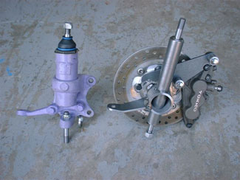

Rescued attachment 007.jpg
And another pic:
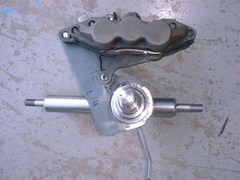

Rescued attachment 002.jpg
.................and interesting info at that....................the "ball extenders" are a nice idea that I haven't seen before. I have made chamfered washers as spacers to do a vaguely similar thing but they look like a much neater way to do it!
Here's the stub axle.
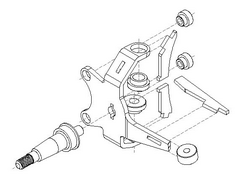

Rescued attachment Cort_upright_03.jpg
Here's the ball extenders too.
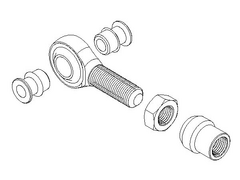

Rescued attachment ball_extenders_01.jpg
Rorty, Have i read this correctly, the upright just above this post is made from 1.6mm steel?
Would you seriously reconmend that for a road going application?
I'm just a little shocked as it seems unfeasible 'light' to my un-educated brain.
quote:
Originally posted by MikeR
Rorty, Have i read this correctly, the upright just above this post is made from 1.6mm steel?
Would you seriously reconmend that for a road going application?
I'm just a little shocked as it seems unfeasible 'light' to my un-educated brain.

I just found this source for trailer stub axles, hubs and studs etc.
I had some unbraked suspension units from them for a trailer I built my mate last year. They were good quality items and quick delivery.